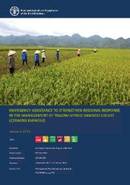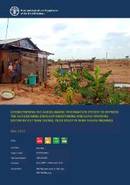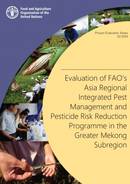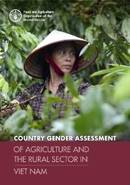Publications
Emergency Assistance to Strengthen Regional Response in the Management of Yellow-Spined Bamboo Locust (Ceracris Kiangsu) - TCP/RAS/3607
Outbreaks of Yellow-Spined Bamboo Locust (YSBL) in LaoPeople’s Democratic Republic and Viet Nam weredamaging many crops in these countries, causing severelosses. The governments and farmers of the two countriesfaced difficulties reducing the migration of the pest.Although in Lao People’s Democratic Republic controlmeasures were successful in preventing losses in thetreated areas, a number of constraints were encountered,limiting their effectiveness. In Viet Nam, actions had beenundertaken to enhance monitoring and implement controloperations. However, the effectiveness of these measureswas restricted by insufficient technical knowledge andexperience, and a lack of equipment, among other issues.Both countries were worried about the possible swarmingacross borders into the existing affected and unaffectedlocust outbreak provinces, and the related impendingsurge in the locust populations, highlighting the need toestablish a real-time surveillance system and cross-borderexchanges on locust situations between the twocountries, to synchronize activities in controlling YSBLinfestations. The project responded specifically to addressthe occurrence of heavy loss on cultivated crops in thetwo countries, and worked towards preventing andlimiting the severe threat posed by locusts and damage tocrops in Lao People’s Democratic Republic and Viet Nam,while reducing pesticide risk to human and animal healthand the environment.
Risk management practices of small intensive shrimp farmers in the Mekong Delta of Viet Nam
Viet Nam is one of the top producers and exporters of farmed shrimp. More than 80 percent of the total production comes from small intensive farms, which occupy less than 10 percent of the land area devoted to shrimp farming. It is the main source of income for many rural households in the Mekong Delta provinces.
This study examines the characteristics of small intensive shrimp farms and socio-economic status of the farm households, and farming practices and performance that are associated with the strategies and preferences for managing production risks. The analysis was based on primary data from a survey of farms raising the whiteleg shrimp (Penaeus vannamei) conducted in Bac Lieu, Ben Tre and Ca Mau provinces from September 2017 to February 2018. Last updated date 03/04/2020.
Strengthening the Agroclimatic Information System to Improve the Agricultural Drought Monitoring and Early Warning System in Viet Nam (News), Pilot Study in Ninh Thuan Province - TCP/VIE/3603
As a result of the effects of El Niño, from late 2014 to summer 2016, serious drought occurred in South Central Coast, Central Highland, and Southern Viet Nam. The main reasons were low rainfall, compared with the annual average rainfall in the same period, and no rainfall in some regions. It is estimated that thousands of hectares of rice and seasonal crops were affected. The drought management approach in the country mainly focuses on crisis management or emergency response, rather than implementing a proactive approach of risk management. In order to manage drought effectively, short-term drought predictions, monitoring and early warning, vulnerability assessment, as well as mitigation and response measures were required. The project aimed to improve the agricultural drought monitoring and National Early Warning System (NEWS) in Viet Nam, by implementing a pilot in one of the country’s drought-affected provinces,Ninh Thuan.
Evaluation of FAO’s Asia Regional Integrated Pest Management and Pesticide Risk Reduction Programme in the Greater Mekong Subregion
Global chemical sales are predicted to grow by about 3 percent per year until 2050, the major part of which will take place in Asia. Many countries in Southeast Asia lack the capacity to handle chemicals management and are in great need to develop institutions, legislation, knowledge and awareness around the issues. The programme “Towards a Non-Toxic Environment in South-East Asia” aimed to reduce health and environmental risks by monitoring, regulating and managing agricultural, industrial and consumer chemicals. This evaluation assesses FAO’s role and contributions to the programme, including work on gender mainstreaming, communication and follow-up actions taken in response to the 2016 mid-term evaluation.
Project code: GCP/RAS/229/SWE
Country gender assessment of agriculture and the rural sector in Viet Nam
The Country Gender Assessment (CGA) was commissioned by the Food and Agriculture Organization of the United Nations (FAO) from October 2017 to February 2018 as a way to gauge Viet Nam’s progress in achieving gender equality in agriculture and the rural sector and as a mechanism to guide FAO’s strategic mission in Viet Nam. Its objective is to inform FAO country-level planning and programming in line with national development priorities and FAO’s mandate and strategic framework. The Assessment is also aimed at facilitating FAO’s contribution to the UN Country Team report on the Convention on the Elimination of All Forms of Discrimination against Women (CEDAW) with up-to date and objective information on the situation of rural women in the country.
The methodology of the CGA included a desk review of policies and programmes on agriculture, food and nutrition security and gender equality, a quantitative analysis of national statistics, in-depth interviews with FAO Viet Nam partners and qualitative surveys and focus group discussions (FGDs) conducted in two provinces (Ninh Thuan and Lao Cai).





